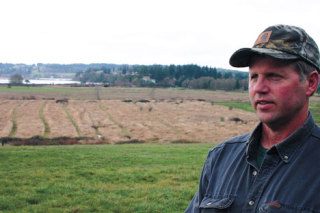Here’s one South End farm that’s going to stay a farm forever. And a wildlife preserve, too.
A conservation easement on 54 acres next to Deer Lagoon has been acquired by the Whidbey Camano Land Trust, the nonprofit agency said Monday.
The easement on the bottomland parcel owned by the Gabelein family was purchased for $600,000 through a state grant and Island County conservation funds.
The process took about 18 months, said Chris Hilton, land protection specialist with the trust.
“We’re excited to have this completed,” she said. “It’s one of the few places on the South End for agricultural production.”
The property is just east of about 420 acres of protected wildlife habitat near Useless Bay northwest of Bayview, including 380 acres at Deer Lagoon owned by the county.
Deer Lagoon is the most extensive estuarine marsh on Whidbey Island, Hilton said.
The 54-acre parcel is owned by the descendants of Raymond and Eva Mae Gabelein. Gabelein died in 2003, and his wife in 2006.
The easement will limit the number of potential homesites to one rather than the six that would be allowed by current zoning.
Under the agreement, the landowner retains ownership and use of the property and the ability to sell or pass the land to others, but the land-use restrictions remain in effect forever, Hilton said.
The easement will allow current and future owners to continue agricultural uses and adjust those uses as needed to ensure that the land remains productive and useful, Hilton said.
“My dad told me flat out that this land should be preserved, and farmed as well,” said Ray Gabelein, the co-executive of his parents’ estate on behalf of himself and his four siblings.
“I think all five of us knew it was the right thing to do, protecting it for future generations,” Gabelein said.
“If we’re going to protect our agricultural land, this kind of thing will continue to be necessary,” he added.
The family owns another 65 acres, mostly south of the easement property, on the hillside along Bayview Road.
The easement process began more than two years ago between the Gabeleins, the land trust and the county.
Money to purchase the easement came in grants from the Island County Conservation Futures Fund and the Washington Farmland Preservation Program, administered by the Washington Recreation and Conservation Office.
Each grant covered about half the cost, Hilton said.
The land trust and county will jointly own the conservation easement, and the trust will monitor and manage it, she said.
Gabelein said the family knew it would have to sell part of its land to settle the estate, but didn’t want to see development on the pristine property.
“Down the road somewhere, development would have been inevitable,” he said, because of the parcel’s prime location and access to Sunlight Beach.
Gabelein said that under the easement arrangement, a new house could be built only in one of two spots on the property: where the existing barn now sits, and on another raised area nearby.
He said the family intends to keep the property, and has no plans to build a house.
“It’s a unique place,” Gabelein said. “Not only is this one of the few places on the South End that has prime farming soils, but when you get down here, you really get away from it all.”
More than 170 bird species have been identified in the area, and many depend on the Gabelein property for foraging, resting and nesting, including rare species such as Peregrine falcon and merlin, Hilton said.
Wildlife on the property includes river otter, beaver, muskrat, mink, coyote, raccoon and deer.
Gabelein said that since his father bought the farm in 1990 from Tom Kohlwes, a member of another long-time South End family of landowners in the area, the property has been used to raise hay and graze cattle.
Gabelein said his father helped to farm the property for Kohlwes for years before he purchased it.
“There’s a potential there to grow potatoes, grain, row crops, anything,” Gabelein said “It’s been farmed continuously.”
“We’re pleased to protect some of the finest farmland on south Whidbey Island, land that has been in agricultural production since 1915,” said Patricia Powell, executive director of the land trust.
“It’s particularly important since well over 73 percent of the land that was being farmed in Island County in 1940 has since been converted to other uses,” she added.
Gabelein agreed.
“As time goes by, this is going to be much more appreciated,” he said. “You only have to take a look at the Kent and Snohomish valleys to see what can happen.”
The Whidbey Camano Land Trust protects natural habitats and rural lands on the two islands in partnership with landowners and the community.
Incorporated in 1984, the land trust is a local, nonprofit, non-political organization that assists private landowners in protecting their scenic, wildlife habitat, natural, historic, farm, forest and shoreline properties.
For more information, visit www.wclt.org.



